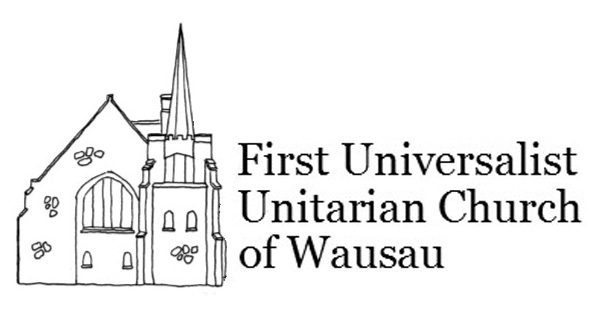Our History
Dating back to 1870, First Universalist Unitarian Church of Wausau has served as a vital liberal religious voice within central Wisconsin and beyond.
History of First Universalist Unitarian Church of Wausau
On December 10, 1870, a society was organized in Wausau known as the Liberal Religion Society, and in 1871, a church was built on the northeast corner of Fifth and McClellan Streets. The first minister, Reverend Schultz, came soon after the church was finished. He conducted a private school in the adjoining parsonage. He was followed by Reverend Fall who stayed until 1879. After he left, no services were held for several years.
In 1886 a new church was erected on a lot donated by Mrs. Mary Scholfield (after whom Schofield was named — the village dropped the first L). on the northwest corner of Fifth and McClellan. This building was sold in 1914 to Mount Sinai Synagogue, and at a meeting in April, 1914, the Universalist Society reorganized under the name First Universalist Church of Wausau. The property on the corner of Fifth and Grant Streets was purchased and Alexander Eschweiler, a well-known Milwaukee architect, was chosen to design the building.
It took one and half years to build the church, which included Yawkey Hall and an attached parsonage. The cost was about $150,000 and Mr. Cyrus Yawkey and Mrs. Alice Yawkey donated the costs for Yawkey Hall, the parsonage, and the furnishings of these buildings.
On November 2, 1915, the church was dedicated and the cornerstone was laid with full ritualistic ceremonies by the Masonic lodge of Wisconsin. In 1956, a remodeling of the parsonage was completed and this east wing now consisted of seven separate classrooms, a church office, the minister’s office, and a combined lounge and library.
On September 26, 2006, our congregation broke ground on a $1.9 million addition. The east wing was demolished and a new handicapped-accessible addition with elevator and atrium was built and completed in August, 2007.
Our History of Religious Freedom
We are Unitarian Universalists, we have a history of religious freedom that includes people of many backgrounds who have different beliefs, but shared values. Get to know us in this short animated video.
Unitarian Universalism is a liberal religious tradition that was formed from the consolidation of two religions: Unitarianism and Universalism. In America, the Universalist Church of America was founded in 1793, and the American Unitarian Association in 1825. After consolidating in 1961, these faiths became the new religion of Unitarian Universalism through the Unitarian Universalist Association (UUA).
Both religions have long histories and have contributed important theological concepts that remain central to Unitarian Universalism. Since the merger of the two denominations in 1961, Unitarian Universalism has nurtured its Unitarian and Universalist heritages to provide a strong voice for social justice and liberal religion.
UU Wausau Today
Today we have a wing for classrooms and offices and an atrium that will function as a welcoming hub for generations to come. This project was designed to offer ground and elevator accessibility for people with disabilities; fire safety for children’s classrooms; a central core for gathering people together; development of the courtyard’s potential; and a relationship with the outdoors through natural light and green spaces.
The 9,000 square feet of new space supports congregational growth and an expansion of programs for children and adults. Dan Helwig of Design Unlimited was the architect for this project, Don Nikolai Construction, the general contractor.
Over two hundred donors contributed more than $1.23 million dollars. Their generosity reflects their commitment to a liberal religious tradition based in freedom, reason, and compassion.
The building design serves as an architectural history of the congregation, showing how the Christian roots of our denomination have grown over the centuries into a tradition that embraces wisdom from many religions, from the arts and humanities, and from science and the natural world.
Just as the glass-enclosed atrium connects us to the world outside, it also showcases the old building’s exterior stonework and serves as a bright connection between the historic sanctuary and the new classrooms and offices.
Like the courtyard at the British Museum and I.M. Pei’s pyramidal glass entrance to the Louvre, the skylighted structure brings the First Universalist Unitarian Church into the 21st century without losing the enduring values of its history.
